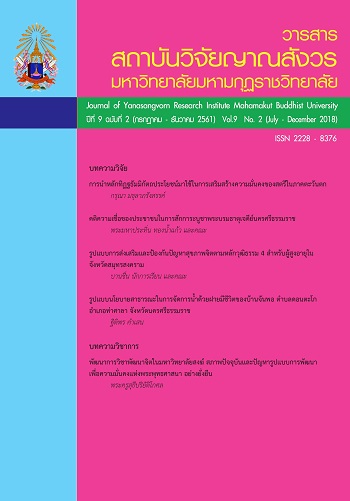Preventing Corruption Strategy in Local Administrative Organization : Case Study in Lower Central Provinces 1
Main Article Content
Abstract
The research titled “preventing corruption strategy in local administrative organization: case study in Lower Central Provinces I, is a quantitative research in conjunction with qualitative research. The purpose of this study was to study the preventing corruption strategy in local administrative organization : a case study of Lower Central Provinces I and to study the problems and obstacles of preventing corruption strategy in local administrative organization : a case study in Lower Central Provinces I and to study the effectiveness of preventing corruption strategy in local administrative organization : case study in Lower Central Provinces I. Quantitative research tools were 400 questionnaires. Data were analyzed by frequency, percentage, mean, standard deviation, t-test, F-test. The interview questionnaires was used as an in-depth interview instrument for qualitative research.
The results found that 1) The preventing corruption strategy in local administrative organizations: a case study in Lower Central Provinces I by the moral aspects in overall were moderate, the popular structural aspects, the popular duty aspects, the popular institutions aspects, the promotion of civil society in the prevention and suppression of corruption were high, the political economy was overall, the average score was moderate. 2) Problems and obstacles include lack of value creation for children, young generation in prevent fraud, lack of justice in society, a discrimination, having a class break, the equal of government official’s performance, the un-rigorous law enforcement, the understanding of power and duty of local administrators from local to national level. 3) The effectiveness of strategy for preventing corruption in local administrative organizations is divided into the following areas: 1. The moral aspect is to say the truth, good governance and administration, good leadership 2. The structure aspect is to have a monitoring system corruption control is strong. 3. The frontline aspect is the strengthening of political institutions and civil society, to promote moral honesty 4. The institutional aspect is to separate the administrative and judicial roles from one another so that there is a system for monitoring the work of the administration. 5. Political economy aspect is the management enhancement to prevent corruption 6. Corruption Prevention / Corruption is strict law enforcement, to review of legal procedures 7. The promotion of civil society in preventing and combating corruption / corruption aspect is promoting the role and empowering the public sector to fight against corruption, promoting people to involve in the prevention and protection, protects the contributors and awards the clerk.
Article Details
References
เกรียงศักดิ์ เจริญวงศ์ศักดิ์ .2547. กลเม็ดเด็ดปีกคอร์รัปชั่น.กรุงเทพมหานคร ชัคเซสมีเดีย.
ชำนาญ ปริบาล.2546. ปัญหาในการดำเนินคดีอาญาแก่ผู้ทุจริต : ตามพระราชบัญญัติว่าด้วยความผิด เกี่ยวกับการเสนอราคาต่อหน่วยงานของรัฐ พ.ศ.2542. กรุงเทพมหานคร. มหาวิทยาลัยรามคำแหง.
ชินนะพงษ์ บำรุงทรัพย์ และคณะ. 2546 . รายงานการวิจัยเรื่อง การคอร์รัปชั่นในการซื้อขายตำแหน่ง ในระบบราชการ. สำนักงานป้องกันและปราบปรามการทุจริตแห่งชาติ.
ท. เทิดธรรม. 2545. คอร์รัปชั่น รูปแบบ ปัญหา กลยุทธ์ในการแก้ไข (สะท้อนความจริงในระบบราชการและสังคมไทย). กรุงเทพฯ : สำนักพิมพ์เมฆขาว.
ธีรภัทร์ เสรีรังสรรค์. 2549. นักการเมืองไทย : จริยธรรม ผลประโยชน์ทับซ้อน การคอร์รัปชั่น สภาพปัญหา สาเหตุ ผลกระทบ และแนวทางแก้ไข. กรุงเทพฯ : สำนักพิมพ์สายธาร.
นิพนธ์ พัวพงศกร และคณะ.2544. คอร์รัปชั่นในวงราชการ : กรณีศึกษาและยุทธศาสตร์การต่อต้านคอร์รัปชั่นในเชิงเศรษฐศาสตร์. ในคอร์รัปชั่นในประเทศไทย : รายงานการวิจัย.กรุงเทพฯ : สำนักงาน ก.พ.
พจนานุกรมฉบับราชบัณฑิตยสถาน. 2525. กรุงเทพฯ : อักษรเจริญพัฒน์.
พรศักดิ์ ผ่องแผ้ว และคณะ. 2539. รายงานผลการวิจัยเรื่ององค์ความรู้ว่าด้วยทุจริตและประพฤติมิชอบในวงราชการไทย.

